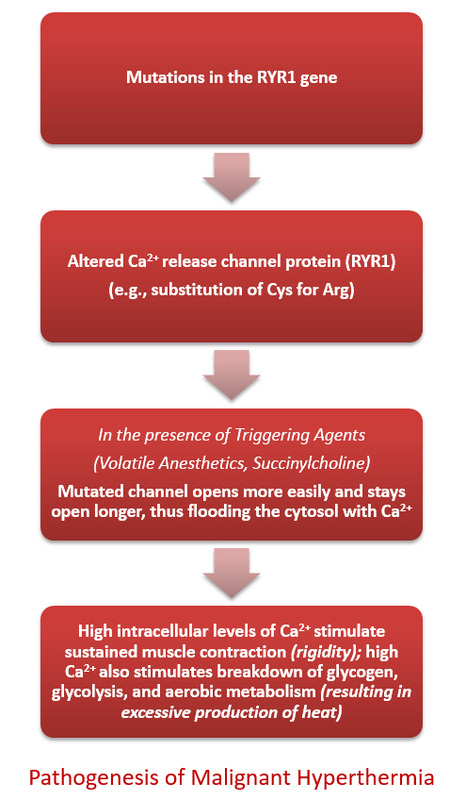8 litman rs, flood cd, kaplan rf, kim yl, tobin jr.
The reaction is caused by genetic abnormalities in proteins that control muscle function. malignant hyperthermia (mh) is a rare inherited autosomal dominant disease. malignant hyperthermia (mh) can be caused by any inhalational anesthetic, other than nitrous oxide. Usually, malignant hyperthermia episodes come on suddenly and are very severe. malignant hyperthermia is a severe reaction to certain drugs that are often used during invasive procedures or surgery.

Fulminant malignant hyperthermia reactions may have only a few of the usual signs.
The reaction is caused by genetic abnormalities in proteins that control muscle function. Patient's temperature was 41.7℃, there was general muscle contractures and increased levels of serum and urine myoglobin. Treat the patient with dantrolene. Doctors then give the drug dantrolene (dantrium). This authoritative and comprehensive 1996 publication looks in depth at a range of medical syndromes characterised by serious and unpredicted internal overheating of the body. The child unfortunately died in the absence of. malignant hyperthermia is a potentially lethal inherited disorder characterized by disturbance of calcium homeostasis in skeletal muscle. malignant definition, disposed to cause harm, suffering, or distress deliberately; Since this disorder can be potentially fatal, pet owners should. 32305961) succinylcholine rarely can cause mh. As soon as malignant hyperthermia is suspected, doctors must act rapidly to treat the condition and prevent complications. If the recovery room is not available, notify the pharmacy department of the malignant hyperthermia event. malignant hyperthermia (mh) is a rare, inherited musculoskeletal syndrome that presents as a hypermetabolic reaction triggered by exposure to volatile anesthetic gases (e.g., desflurane, enflurane, halothane, sevoflurane) or the depolarizing muscle relaxant, succinylcholine.
It is caused by a rare, inherited muscle abnormality. The use of this drug had decreased the mortality rate of mh to 10% (stolworthy & Despite the rarity of malignant hyperthermia, healthcare facilities that use known triggering agents must be fully prepared to treat it. Dantrolene sodium is a postsynaptic muscle relaxant with multiple indications in the fields of anesthesiology and neurology. malignant hyperthermia is a severe reaction to particular anesthetic drugs that are often used during surgery and other invasive procedures.

( 28144147) features which may suggest a diagnosis of lethal catatonia:
Clinical presentation, treatment, and complications of malignant hyperthermia in north america from 1987 to 2006. ( 28144147) features which may suggest a diagnosis of lethal catatonia: 8 litman rs, flood cd, kaplan rf, kim yl, tobin jr. malignant hyperthermia (mh) is a potentially fatal pharmacogenetic disorder of skeletal muscle calcium regulation. What is the initial dose of dantrolene for malignant hyperthermia treatment? Unfortunately, regardless of treatment, malignant hyperthermia is often fatal. Symptoms include muscle rigidity, very high body temperature, increased blood acidity, rapid breathing, a faster heart rate and abnormal heart. malignant hyperthermia is a rare but very serious complication with high mortality and the treatment is based on the early administration of dantrolene sodium. 32305961) succinylcholine rarely can cause mh. treatment of malignant hyperthermia rapid cooling of the body. A drug called dantrolene may also be effective. Mhaus developed and promulgated standardized treatment guidelines for mh patients. The reaction is caused by genetic abnormalities in proteins that control muscle function.
Due to this reason malignant hyperthermia is also termed as "canine stress syndrome." Infrequently, extreme exercise or heat stroke can trigger malignant hyperthermia in someone with the muscle abnormality. An analysis of cases from the north american malignant hyperthermia registry. malignant hyperthermia (mh) is caused by a genetic disorder of the skeletal muscle that induces a hypermetabolic response when patients are exposed to a triggering agent such as volatile inhaled anesthetics or depolarizing neuromuscular blockers. Dantrolene sodium is a postsynaptic muscle relaxant with multiple indications in the fields of anesthesiology and neurology.

These triggers create an increase of calcium, which eventually causes hyperthermia and possibly death.
An analysis of cases from the north american malignant hyperthermia registry. malignant hyperthermia is quite different than the hyperthermia one associates with heat stroke or infection. As earlier mentioned, if a patient shows any signs of malignant hyperthermia, it is important that an immediate response is given to avoid any further complications. This means it's passed down from parents to children. malignant hyperthermia (mh) is a rare, inherited musculoskeletal syndrome that presents as a hypermetabolic reaction triggered by exposure to volatile anesthetic gases (e.g., desflurane, enflurane, halothane, sevoflurane) or the depolarizing muscle relaxant, succinylcholine. malignant hyperthermia is a genetic condition (runs in families) that results in a severe reaction to anesthesia. If the condition is recognized early in an animal under anesthesia, supportive measures may be able to save the animal. Signs and symptoms of mh include marked hyperthermia, a rapid heart rate, rapid breathing, acidosis, muscle rigidity, and breakdown of muscle tissue (rhabdomyolysis). Due to this reason malignant hyperthermia is also termed as "canine stress syndrome." If the recovery room is not available, notify the pharmacy department of the malignant hyperthermia event. Without prompt treatment, the complications caused by malignant hyperthermia can be fatal. Doctors then give the drug dantrolene (dantrium). This authoritative and comprehensive 1996 publication looks in depth at a range of medical syndromes characterised by serious and unpredicted internal overheating of the body.
View Malignant Hyperthermia Treatment Pictures. Anesthesiology faculty in the room assist and offer guided instruction to aid the. malignant hyperthermia (mh) is a rare inherited autosomal dominant disease. Signs and symptoms of mh include marked hyperthermia, a rapid heart rate, rapid breathing, acidosis, muscle rigidity, and breakdown of muscle tissue (rhabdomyolysis). This authoritative and comprehensive 1996 publication looks in depth at a range of medical syndromes characterised by serious and unpredicted internal overheating of the body. treatment of malignant hyperthermia rapid cooling of the body.






